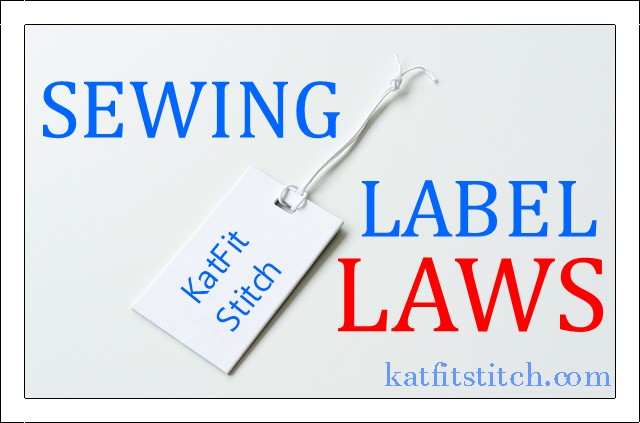If you sew for a living, you’re going to want to put a label on it.
A lot of home sewers don’t know that they must abide by labeling requirements under the Federal Trade Commission.
And it’s the same internationally.
Under the textile and wool acts you must label the garments you’ve sewn when intending to sell them. An exception to the rule is fiber content for upcycled fabric, personal use, and work for hire.
Why Do I Care?
You should care if you don’t want to be sued.
There are so many people who don’t label their garments when selling at craft shows and flea markets. But YOU should. You should because there are FTD scouts who police the selling of textiles and wools.
All it takes is being caught one time, to lose your livelihood.
There have been many court cases against manufacturers who don’t comply. Most are given warnings, and if they don’t comply they are charged. Jail time has also been given in extreme cases.
Label laws are meant to keep the consumer safe. They aren’t meant to make a sewer’s life miserable.
Putting a label on your clothing is as difficult or easy as you want to make it.
The world is full of rules. Either you abide or pay the consequences.
Rules and regulations are normal.
If we didn’t have label laws, someone might claim a garment doesn’t contain wool. If a consumer purchases that garment, and trusts the seller, only to fall ill with an allergic reaction because it actually DID contain wool, lawsuits would be in abundance.
And people would be harmed.
To prevent that harm, the FTC sets requirements and regulations and makes them law.
It’s up to us to abide, but who would want to be caught with their pants down. Most people want a legit sewing business.
And following FTC rules makes it legit.
So, put a label on it.
What Should Be On The Label?
- Fiber content
- Fibers country of origin
- Identification of manufacturer (or RN#)
- Care instructions
Children’s Clothing
Children’s clothing are subject to stringent rules and regulations mostly for sleepwear and choking hazards. They must abide by the Consumer Product Safety Commission’s rules on fire-retardant and testing.
You can read more through the following link, Flame Resistant Sleepware.
Licensed Fabric
Licensed fabric such as Disney have strict rules. Companies pay Disney for the use and sale of products with their licensed art and logos on it.
If your company does not pay for that, they might be fined.
Believe it or not, there are scouts out looking at craft show to see if you are infringing on copyright laws.
And Disney prints are under a copyright.
The only exception would be upcycled fabric. If you use a Disney printed sheet and sew a dress out of it, there is no worry.
Adult Clothing
Adult clothing as well as children’s, need to have a label on it. There are many companies that will print labels for you.
Many can be found on Etsy
There are far too many rules to mention in this one post, so when in doubt, go to the source here.
Excluded Items
- Bags
- Auto seat cushions
- Covers for sports equipment
- Wall decorations
- Tents
- Sleeping masks
- Knapsacks and backpacks
- Hot pads
- Pet clothing
- Holiday decorations
- Tea cozies
- Leather goods and trims
- Baby equipment
- Diapers
These are just some of the exempt items. For a full list, you can go to the FTC website.
Upcycled Clothing
Upcycled clothing doesn’t require as stringent rules as new fabric. Fiber content is often unknown when using upcycled fabric, so a best guess senario is the norm.
You still have to label upcycled garments, but most don’t because there is already a label attached, and often upcycled clothing is just a partial alteration.
For example, a jean jacket may have different sleeves and then sold that way.
A pair of jeans may be turned into a Boho jean skirt.
I like to sew with upcycled material because it’s generally easier to label, given the fact that the previous label already has fiber content, care instructs etc.
You already know what’s in it.
Selling vs Work For Hire
The exception to the label laws depends on what the purpose of the garment is.
If you intend on selling it, all garments need labels to protect the consumer from fraudulent claims, as well as harmful substances.
If you don’t intend to sell it, and you are sewing for yourself, you don’t need to worry about any label laws. You can disregard everything listed in the FTC.
If you work for hire, meaning you are a seamstress hired to sew something for someone. You don’t need to comply to the label laws.
You don’t need to put a label on the garment you sew.
Why?
Because your customer is buying your services. THEY purchase the fabric, and supplies. THEY know what is going into it, and therefore they are in a way, making it for themselves.
Repercussions
In most cases, if you don’t follow label laws and you’re found out, you will be warned. If you deliberately don’t comply, there are repercussions like fines and jail time.
Conclusion
In conclusion, I know it sounds like a bother to put a label on the garment you sell, but in the long run, you are helping your customer by keeping them safe.
They will be safe from fraud – False claims that say a garment is made out of something it’s not.
Think of how many people buy silk dresses, thinking they are silk, when really it’s polyester. Maybe they paid way too much because they thought it was made out of expensive fabric.
Label laws are a way to hold the garment industry accountable.
In the long run, it will be better for everyone.
And really, it isn’t much to get some labels made up. It isn’t even hard to get a Registered Identification Number (RN#) for your sewing business.
If you want to be a legit sewing business, getting labels printed and sewing them into your garment should be nothing at all.
Most of the time, people get all worked up over sewing label laws, but really, it should just be the norm if you want to sell your sewing and protect your customers.
HAPPY SEWING!
And remember… PUT A LABEL ON IT!
Resources

